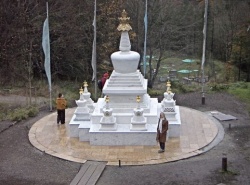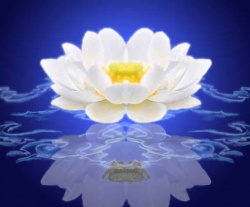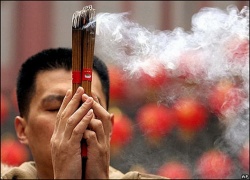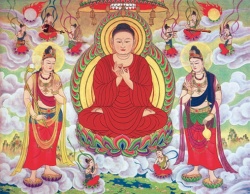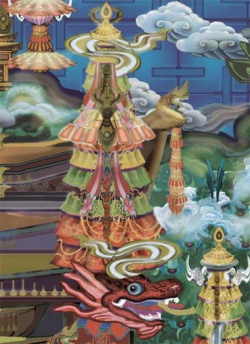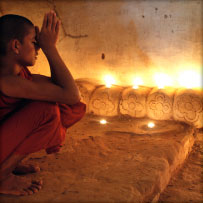The meaning of Stupas
“Stupas… demonstrate the triumph of enlightenment’s wisdom over suffering’s ignorance. They are memorials… to the possibility of freedom from suffering for all beings. They signal the triumphal reality of a nature that enables beings to evolve to experience the ultimate fulfilment of perfect bliss, beyond death and unsatisfying life. Stupas stand as eloquent testimony to the higher purpose of life, beyond competing or struggling, getting or spending. Consciously or subliminally, they help turn people’s minds away from their frustrating obsessions and towards their own higher potential”
(Professor Robert Thurman, from the Foreword to Buddhist Stupas in Asia: the Shape of Perfection).
Stupa is a Sanskrit word that means “to heap” or “to pile up” and refers to the mound-like shape of the earliest stupas.
The Mahaparinirvana Sutra tells us that it was the Buddha himself who outlined the basic design of the stupa. The story begins at Buddha’s deathbed. When he realized that death was imminent, Buddha gave instructions about the disposition of his body. He said that his body should be cremated and the relics divided up and enclosed in four different monuments. These monuments were to be erected at the following places, marking important milestones in the Buddha’s spiritual journey: at Lumbini, where he was born; at Bodhgaya where he attained Enlightenment; at Sarnath, where he gave his first teaching; and at Kushinagar, where he died, entering parinirvana, or ultimate liberation.
Giving a practical demonstration, he folded his outer yellow robe over and over until it became a rough cube. Then he put his begging bowl over it. These two elements, the square and the dome, are present in every stupa (India), dagoba (Sri Lanka), chorten (Tibet), chedi or pagoda (Burma), t’ap (Korea), ta (China), tarp (Vietnam), thaat (Laos), sotoba (Japan), or chandi (Java).
The stupa, universal throughout Asia, evolved into more than a reliquary monument. It has become an expression of the ideal of Enlightenment. Statues represent the Buddha’s body, Dharma texts his speech. Stupas are representations of the Buddha’s mind. They reveal the path to enlightenment, or how the mind can actualize its full potential and be transformed into enlightenment. Stupas can be seen as an expression of the five elements.
Earth, which spreads out in the four directions, provides the solid basis.
The dome is the garbha (“womb”), primordial, creative Water – formless potentiality. It is also called the anda, or egg.
The conical spire is Fire, which always rises upwards. It represents the wisdom which burns away ignorance.
The crescent moon is Air, expansive, waxing and waning (an ancient symbol of the feminine).
The circle is Space, wholeness, totality, with no end or beginning.
Finally, above the circle is a jewel, which represents a higher state of reality, gone beyond the five elements. It is the ushnisha, present on the crowns of all Buddhas, revealing their perfect, enlightened state. This ascent to perfection is laid out with precision in an Enlightenment stupa.
The base represents ethics; the abandonment of the ten non-virtues of body, speech and mind – the foundation of the Path. Upon this foundation the practice that leads to Enlightenment is built. Above the base is the throne, upon which the actual stupa will be placed. Above the throne are four steps – the four mindfulnesses, the four perfect efforts, the four miraculous feats, and the five powers. The base of the vase is the five forces.
The dome or vase represents the seven aspects of Enlightenment; where the actual Buddha is situated, it represents the celestial mansion of enlightened beings. The harmika, or cube is the peak of all previous attainments. It is where one enters the path of the superior beings, and is the point in the path are one first directly realises selflessness or emptiness. Stupas in Nepal have eyes painted on the harmika to emphasise this crucial moment of perception.
The base is ethics, the dome and harmika are the path. Beyond this begins the result – the conical spire, where wisdom burns away the residue of ignorance. The thirteen rings symbolise the ten powers (or bhumis), and the three close mindfulnesses of the Buddha.
Above the spire is an umbrella, which represents the Buddha’s great compassion, protecting us from suffering just as an umbrella protects us from the sun and rain.
Above the umbrella are the moon and the sun, and these two represent bodhichitta – the altruistic intention to bring all beings out of suffering and into the bliss of enlightenment. There are two types of bodhichitta, conventional and ultimate. The moon symbolizes conventional bodhichitta and the sun ultimate bodhichitta. Above the sun is the jewel – the final result, Enlightenment, or Buddhahood.
So, on the foundation, free of the ten non-virtues, one trains on the path and then finally attains Enlightenment – as the Buddha did.
The entire stupa represents the ultimate qualities of the Buddha’s mind and is therefore a very precious and holy object. By making offerings, prostrations, circumambulating – and especially by giving donations to help build a stupa, a huge amount of virtue or merit is received that will help one to train in the path and which becomes a cause for the quick attainment of Enlightenment.
“Ten Traditional Purposes of Stupas”, extracted from A Stupa for Geshe Lama Konchog by Tenzin Zopa.
To remind one of a teacher
To act as a reliquary, which contains the relics of a teacher and embodies the enlightened mind, and to serve as the focal point for the continuation of the buddha-activity of a teacher
To magnetize enlightened energy
To speed a teacher’s rebirth
To promote longevity
To create peace and harmony in society
To magnetize wealth
To turn back invading armies
To pacify physical and mental illness, pestilence, and disease
To actualize enlightenment
Holy Objects
Found in all Buddhist countries, stupas are the archetypal symbol of the enlightened mind. Even just seeing a stupa brings immense benefit — incredible purification, incredible merit, and incredible blessing. Stupas transcend the limitations of language to plant the seeds of enlightenment and peace in the minds of all who see them, human or animal, Buddhist or non-Buddhist.
“There is a need in the world to develop compassion and a warm heart. Building stupas helps develop so much peace and happiness for numberless sentient beings. As a result, wars, disease, and desire will all be pacified. Instead of feeling hopeless, people will gain courage. This is about peace – for the beings that see it, for the whole country, for the entire world, for all sentient beings” Lama Zopa Rinpoche
Benefits of Holy Objects such as Stupas
“We talk about good luck and success, and we use feng shui and many other methods to have them. Some people don’t believe in or use feng shui or those other methods but they have their own understanding of how to make their life successful. They may think, “If I study this, I will be successful in my job”.
However, if you don’t have good karma, if you don’t have merit you can’t even find a good doctor that can cure your sickness. Or even if you find a good doctor, they won’t be able to cure your disease if you don’t have merit. Even if you use feng shui, it won’t work if you don’t have merit because feng shui is only an external arrangement. Feng shui alone won’t work. You first have to have the merit, the good karma.
It is the same with the spiritual path. If you don’t have merit, you can’t find the right virtuous friend to reveal Dharma to you, to show you the path to happiness, to liberation and enlightenment. The very first thing is to find someone who can show you the path to happiness and not the path to suffering. For this to happen you need merit, because without merit you can’t meet an unmistaken guru who can reveal the right path.
Having these holy objects such as Stupas makes life so easy; they make it easy to collect merit (positive energy/potential) and to create the cause of any happiness, any success. You can create all the good luck, all good fortune you want. By just seeing holy objects such as Stupas you collect unbelievable merit, purify your mind and plant seeds of enlightenment.”
